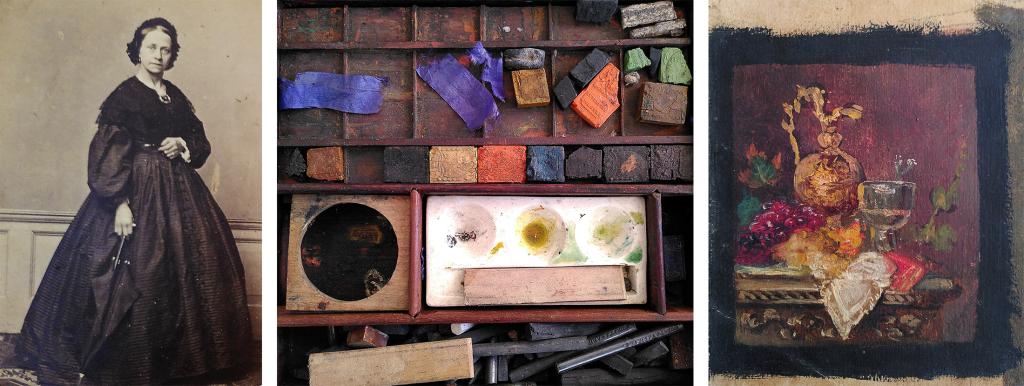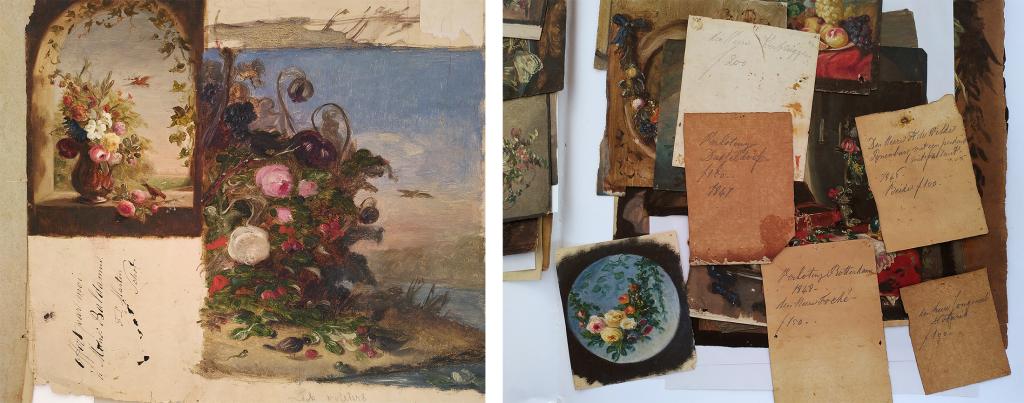Francina Schot Archive

The RKD recently acquired the archive of artist Francina Louise Schot (1816-1894). Schot specialised in paintings depicting nature and flowers. Her archive came to the RKD together with the studio cabinet in which it was kept. Besides personal documentation, it contains Schot's painting materials, a velvet bag and a large number of beautiful drawings, oil sketches and watercolours.
Successful career
Francina Louise Schot was born and raised in Rotterdam, the city where she also worked for most of her life. Although Schot did not come from an artistic family, she learnt to paint at an early age. At nineteen, she exhibited for the first time at the Rotterdam exhibition of Living Masters. A successful career followed: in 1847, at the age of 30, Schot became an honorary member of the Amsterdam Royal Academy of Arts, at a time when female artists were admitted only sparsely. The considerable acquisition prices of her paintings - amounts as high as 400 guilders - show that Schot was already highly regarded in her own time.
Shared love of nature
Schot is best known for her abundant floral still lifes, where the colours almost burst off the canvas. To provide her paintings with as much detail as possible, she often sketched studies of nature. Many of these drawing sessions took place in the rose garden of widower Pierre Henri Martin (1793-1882) in Kralingen (now a Rotterdam district, then its own commune). The two shared a great love of nature and married in 1850. Martin was a dompteur and owner of a menagerie. In 1857, he became the first director of the Rotterdam Zoo, now known as Blijdorp Zoo. Schot continued to exhibit her paintings and managed to win several prestigious prizes, for example at an exhibition of the Royal Dutch Horticultural Society in 1856. Tuinbouw in 1856.

2. Painting material by Francis Schot, collection RKD
3. Oil sketch by Francis Schot, collection RKD
Unknown archive
The archive of Francis Schot recently turned up in the estate of Tonnie van Dixhoorn-van Oosterhout. She was the widow of Frits van Dixhoorn, who came into contact with the granddaughters of the Martin-Schot couple while writing a book about Pierre Henri Martin. They left Francis Schot's personal archive to him, which included documentation on Martin. During the life of the Van Dixhoorn-van Oosterhout couple, the studio cabinet - in which Schot's archival material was kept - was not allowed to be opened, so the existence of the archive was unknown to their descendants. After Mrs Van Dixhoorn-van Oosterhout's passing, her children discovered the contents of the cabinet. By taking advantage of the remission arrangement, the archives could be transferred to the state in ownership.
Artist life
The studio cabinet contains a wealth of very diverse material. From it emerged sketchbooks, painting materials, drawings, preliminary studies and watercolours, which give an impression of Francina Schot's working methods, her artistic interests and the high quality of her work. In addition, the archive consists of personal documentation such as correspondence, family photos, documents of her husband Pierre Henri Martin and photos of Blijdorp Zoo. The variety of (archival) material makes it a very rich artists' archive that gives a wonderful insight into female artists' lives in the nineteenth century. Extra special is that many of the sketches in the archive mention on the back who the commissioner or buyer of the work was, giving an insight into Francina Schot’s clientele as well.

2. Oil sketches by Francis Schot with the name of the client on the back, collection RKD